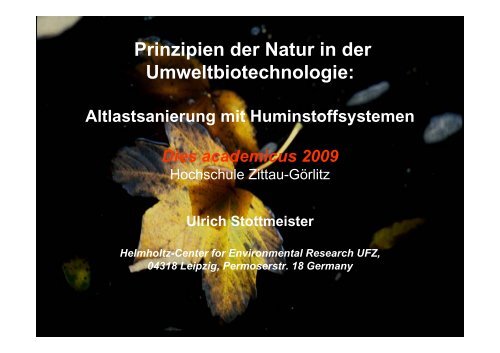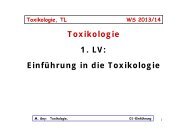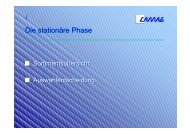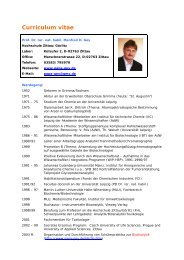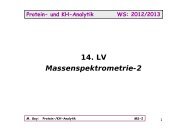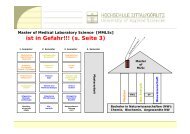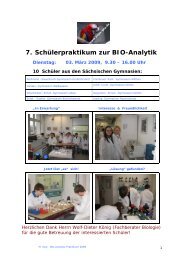Prof. Ulrich Stottmeister
Prof. Ulrich Stottmeister
Prof. Ulrich Stottmeister
Sie wollen auch ein ePaper? Erhöhen Sie die Reichweite Ihrer Titel.
YUMPU macht aus Druck-PDFs automatisch weboptimierte ePaper, die Google liebt.
Prinzipien der Natur in der<br />
Umweltbiotechnologie:<br />
Altlastsanierung mit Huminstoffsystemen<br />
Dies academicus 2009<br />
Hochschule Zittau-Görlitz<br />
<strong>Ulrich</strong> <strong>Stottmeister</strong><br />
Helmholtz-Center for Environmental Research UFZ,<br />
04318 Leipzig, Permoserstr. 18 Germany
Marc Aurel (121 – 180 u.Z.)<br />
Selbstbetrachtungen 8. Buch:<br />
Das Wunderbare an der Natur ist,<br />
dass sie all das, was unnütz zu sein scheint, in ihr eigene Substanz<br />
umwandelt und daraus wieder neue Dinge macht. Dadurch hat sie<br />
weder Stoff von außen nötig und braucht<br />
keine Stelle, wohin sie das Schlechtgewordene wegwirft.<br />
Einleitung zu: W. Ziechmann, Huminstoffe und ihre Wirkungen, Spektrum Verlag 1996
Nach Marc Aurel:<br />
1. Umwandlung aus der eigenen natürlichen Substanz<br />
und Wegwerfen ?<br />
Die Rolle von Huminstoffsystemen in der Natur<br />
2. Neue Dinge aus der eigenen natürlichen Substanz?<br />
Die Chemie und die Anwendung der<br />
Huminstoffsysteme
Nach Marc Aurel:<br />
1. Umwandlung aus der eigenen natürlichen Substanz<br />
und Wegwerfen ?<br />
Die Rolle von Huminstoffsystemen in der Natur
Das Polymerproblem 1<br />
0.2 Gt Weltproduktion an Kunststoffen 2003
Hanoi, Vietnam, März 2006 Foto: <strong>Stottmeister</strong>
Palermo, März 2006 Foto <strong>Stottmeister</strong>
Tripolis, Libyen, August 06<br />
Foto: <strong>Stottmeister</strong>
Das Polymerproblem 2:<br />
• Lebende Biomasse um 800 Gt C insgesamt<br />
• Tote Biomasse (im Humus usw.)<br />
etwa doppelt so viel = 1600 Gt C
Photosynthese: CO 2 und Sonnenlicht<br />
Biopolymere:<br />
Zellulosen<br />
Hemizellulosen<br />
Lignine u.a<br />
Huminstoffbildung aus den<br />
abgestorbenen Resten<br />
Wassertransport löslicher<br />
Anteil<br />
Wassertransport: Mineralstoffe und Spurenelemente<br />
Zeichnung: UFZ
Foto: <strong>Stottmeister</strong>
Foto: UFZ
Holzzersetzender Pilz<br />
Foto: UFZ
„Chemical structure“ of lignine<br />
Xylan<br />
Lignin-Struktur<br />
Non-aromatics
Polymerverbindungen in<br />
Natur und Technik<br />
Neusynthese aus reinen Rohstoffe<br />
(erneuerbare Rohstoffe)<br />
Teil- Entsorgung: biologischer Abbau<br />
mit CO 2-Bildung (Kohlenstoffkreislauf)<br />
Kein Äquivalent<br />
Bildung eines neuen Typs von<br />
polymeren Verbindungen mit neuen<br />
universellen Aufgaben :<br />
Huminstoffsysteme<br />
Neusynthese aus reinen Rohstoffen<br />
(fossile Rohstoffe)<br />
Teil-Entsorgung: Verbrennung mit<br />
CO 2-Bildung, Wärmenutzung<br />
Bedingte Wiederverwertung durch<br />
Polymerstoffrecycling<br />
Kein Äquivalent
Nach Marc Aurel:<br />
2. Neue Dinge aus der eigenen natürlichen Substanz?<br />
Die Chemie und die Anwendung der<br />
Huminstoffsysteme
mesomere Grenzstrukturen<br />
Phenol
OH<br />
OH<br />
σ−<br />
..................... O<br />
σ +<br />
σ +<br />
σ +<br />
σ +<br />
.....................<br />
O<br />
+ M-Effekt der<br />
OH- Gruppen<br />
σ −<br />
σ +<br />
σ +<br />
-I-Effekt der<br />
C=O-Gruppen<br />
Elektronenverteilung im Hydrochinon-Chinon-System
OH<br />
OH<br />
+ O2<br />
O<br />
OH<br />
O<br />
OH<br />
+ O2<br />
Hydrochinon Semichinon Peroxidradikal<br />
Reaktion von Hydrochinon mit Sauerstoff.
Huminstoffe: Die klassische Einteilung<br />
Fulvinsäuren Huminsäuren Humine<br />
Färbung<br />
2000 Molekulargewicht 35 000<br />
45 % Kohlenstoffgehalt 62 %<br />
Wasserlöslichkeit<br />
48 % Sauerstoffgehalt 30 %
Huminstoffsysteme<br />
+ Kationen<br />
+ Silikate<br />
+ andere organische Verbindungen
Funktion der Huminstoffsysteme im Boden<br />
- Stabilisierung des Bodengefüges<br />
- Binden von Wasser, Nährstoffen, Spurenelementen<br />
- Erhöhung des Wasserhaltevermögens<br />
- Verbesserung von Belüftung und Permeabilität<br />
- Aggregatbildung<br />
- Erosionsschutz<br />
- Filterwirkung<br />
- Immobilisierung von organischen Schadstoffen<br />
und Schwermetallen<br />
- Binden und Schutz von Proteinen und Lipiden
Hangschnitt in den Subtropen (Nordvietnam) Foto: <strong>Stottmeister</strong>
Moorwassersenke an der Ostsee<br />
Foto: <strong>Stottmeister</strong>
Reaktionen des<br />
Huminstoffsystems<br />
Huminstoffsystem-<br />
Bildung<br />
Konformationsphase<br />
Radikalphase<br />
Biosynthese von<br />
Aromaten und<br />
Aliphaten<br />
in lebender Materie,<br />
Biopolymere<br />
Biodegradation und<br />
Bildung von<br />
mikrobieller<br />
Biomasse<br />
„Alterung“ des Huminstoffsystems<br />
Interaktion von Huminstoffen mit Kationen, Silikaten u.a.<br />
Vorstufen von Huminstoffen<br />
Radikalreaktionen, Reaktionen mit Luftsauerstoff,<br />
Aromaten-Interaktionen zu EDA-Komplexen<br />
Kohlehydrate<br />
Fette, Proteine<br />
u.a.<br />
mikrobieller Abbau<br />
Phenole, aromat.<br />
Aminosäuren,<br />
andere Aromaten<br />
aliphatische Fragmente aromatische Fragmente
Pseudoformel eines Huminstoffs
-C00H groups<br />
of aromatics<br />
Formation of salts<br />
(Fe +++ ,Al +++ et al.)
lue<br />
red<br />
white<br />
black<br />
Three-dimensional pseudo-formula of a<br />
humic substance
Kalottenmodell eines Huminstoffes nach Schulten
Teil 2 Anwendungen der Huminstoffe in der<br />
Umwelttechnik
Der HSS-Forscher mit<br />
Intentionen zur Praxis<br />
Zeichnung: UFZ
Chemische und physikalische Eigenschaften<br />
von Huminstoffsystemen<br />
Jedes HSS ist ein chemischer Universalreaktor<br />
- Ionenaustauscher<br />
- Komplexbildner<br />
- Puffersubstanz<br />
- Katalysator<br />
- Radikalstabilisator<br />
- Radikalfänger<br />
- Reduktionsmittel für Schwermetalle (Uran VI, Chromat)<br />
- Hohe Adsorptionskapazität<br />
- Elektronenfänger<br />
- Brücke zu mineralischen Substanzen<br />
- Brücke zu den Mikroorganismen als Carrier<br />
in der HS- Atmung<br />
- Halbleiter<br />
- Entropiebremse
Huminstoffsystem: Huminstoffe, Wasser, Ton, Bakterien<br />
Zeichnung: UFZ<br />
Schadstoff
Adsorption an Tonmineralien:<br />
Brücke zur anorganischen Welt
Huminsäuren reduzierende Mikroorganismen<br />
Huminsäure oxidiert Huminsäure reduziert<br />
Elektronenfluss<br />
Acetat CO 2<br />
Fe(II)<br />
Fe(III)<br />
Biotische<br />
Reaktion<br />
Abiotische<br />
Reaktion<br />
Huminstoffatmung: Brücke zur belebten Natur
Reaktion eines Schadstoffes mit SOM (1) und DOM (2)<br />
Am Bespiel des zu den EPA-PAK gehörenden cyclischen aromatischen Kohlenwasserstoffs<br />
Acenaphthylen werden die Reaktionsmöglichkeiten gezeigt:<br />
- Sorptionsgleichgewichte zwischen SOM und DOM<br />
- DOM als Transporteur des Schadstoffes<br />
- Oxidation zu sauerstoffhaltigen Produkten (z.B. Naphthalsäureanhydrid)<br />
- Bildung von „bound residues“
Huminstoffsysteme können auch mit nicht-natürlichen<br />
organischen Verbindungen reagieren, zum Beispiel mit<br />
- Sprengstoffen<br />
- Pflanzenschutzmitteln<br />
- Agrochemikalien<br />
- Medikamentresten<br />
- diversen wasserunlöslichen Chemikalien<br />
Stichwort: bond residues
Die Sanierung der Schwelwasserdeponie<br />
„Phenolsee“<br />
Die
1.Introduction:<br />
The story of the „Phenol Lake“
Lignite Areas in<br />
Germany<br />
Lignite was the most important<br />
source for energy and chemistry<br />
In Germany up to 1945<br />
(the end of world war II)<br />
and in<br />
East Germany up to 1989<br />
(German unification)
Lignite based industries in<br />
In East Germany<br />
electro-chemistry<br />
gasification<br />
liquefaction<br />
carbonification<br />
coking
Lignite open cast mine near Leipzig (1995)<br />
Today: recreation lake with marina<br />
Foto: UFZ<br />
Foto: UFZ
Lignite based industries in East Germany<br />
electro-chemistry<br />
Products<br />
Coke, charcoal, synthesis<br />
gas, tar, tar oils and others<br />
Pyrolysis-processes:<br />
heating without air contact<br />
gasification<br />
liquefaction<br />
carbonification<br />
coking<br />
Waste:<br />
1. Smelling gas emissions<br />
2. Highly loaded condensed<br />
Water (with phenols, ammonia,<br />
fatty acids, heterocyclic compounds)
2. Highly loaded condensed<br />
water<br />
with phenols, ammonia,<br />
fatty acids, heterocyclic compounds<br />
„treatment“ up to 1989<br />
Inlet into<br />
rivers open cast mines physikochemical and<br />
biological<br />
=<br />
treatment plants (single plants)<br />
=<br />
Dilution penetration into soil/underground<br />
Clay layer: formation of the „Phenol lake“
pH-value 8.5<br />
Monophenols 8.0 g/l<br />
Polyphenols 9.0 g/l<br />
Fatty acids 8.8 g/l<br />
H2S 0.8 g/l<br />
NH 3<br />
Main constituents of a waste water<br />
from lignite carbonification<br />
5.7 g/l<br />
COD (KMnO4 ) 95 g/l<br />
BOD5 31 g/l<br />
thiophene, mercaptans, N-heterocyclic compounds<br />
Mass balance:<br />
1000 kg briquette form about 350 kg contaminated water
„Chemical structure“ of lignite<br />
(derived from lignine)<br />
Cut at<br />
> 600 ° C<br />
Xylan<br />
Lignin-Struktur<br />
phenols
Lignite pyrolysis plant 1989 (near Leipzig)<br />
(built in 1934, closed 1990)<br />
Foto: UFZ
The „Phenol Lake“ 1994<br />
Fotos: UFZ
1994 Foto: UFZ
1994 Foto: UFZ
Characteristic of the deposit<br />
1994<br />
area 9 ha<br />
water volume 2 Mill. m3 maximum depth 27 m<br />
visibility 3 cm<br />
dissolved- O2 0<br />
strong smell of H 2 S and organic<br />
sulphur compounds
Depth <strong>Prof</strong>iles of Concentration: 1995<br />
Tiefe<br />
(m)<br />
Phenole<br />
total<br />
mg/l<br />
NH4 + Depth Total<br />
Total phenols<br />
- N<br />
mg/l<br />
COD<br />
mg/l<br />
DOC<br />
mg/l<br />
0 7 79 964 263<br />
5 23 85 980 274<br />
10 86 134 1350 405<br />
Tiefe<br />
(m)<br />
Phenole NH4<br />
total mg/l<br />
+ - N<br />
mg/l<br />
COD<br />
mg/l<br />
DOC<br />
mg/l<br />
15 202 221 2200 627<br />
20 228 239 2290 689<br />
25 219 250 2245 690
Remediation strategy:<br />
An interdisciplinary work<br />
of<br />
Chemists<br />
Hydrologist<br />
Hydrobiologists, Microbiologists<br />
and<br />
Technologists<br />
of the<br />
Helmholtz-Center for Environmental Research<br />
UFZ<br />
and different companies
2. The full scale remediation: A realised example<br />
for Enhanced Natural Attenuation (ENA)<br />
2. 1 The strategy of the chemists:<br />
Application of humic matter chemistry
Conclusion of the chemistry of<br />
humic matter systems.<br />
1. Macromolecules form colloids: coagulation with electrolyts,<br />
acidification<br />
2. Macromolecules form salts: insoluble salt formation: Fe +++<br />
3. Macromulecules include smaller moleculs destruction of intramolecular<br />
bounds<br />
4. Formation of bound residues: destruction of<br />
macromolecules<br />
5. Avoidance of<br />
formation of new macromolecules absence of oxygen and low<br />
molecular phenols
Conclusion of the chemistry of<br />
humic matter systems.<br />
- Acidification pH 4.0 is necessary<br />
- iron-III-salt- addition,<br />
- no oxygen and reactive phenols together<br />
(new formation of macromoleculs)
Laboratory-scale experiment:<br />
Addition of iron(III)-chlorid solution at pH 4.5<br />
Foto: UFZ
2.2 The strategy of the hydrologists:<br />
The PONTOS EUXINOS –Effect
„Pontos Euxinos“-(black sea) effect:<br />
formation of stable zones in a water body<br />
weather<br />
seasonal<br />
changes<br />
KE<br />
enclosures<br />
Zeichnung: UFZ<br />
aerobic<br />
anaerobic
2.3 The strategy of microbiologists:<br />
Degradation within complex microbial<br />
communities
1E+08<br />
1E+07<br />
1E+06<br />
1E+05<br />
1E+04<br />
1E+03<br />
1E+02<br />
1E+01<br />
1E+00<br />
1E-01<br />
0 3 6 9 12 15 18 21 24 27<br />
Tiefe(m)<br />
Gesamtzellzahlen/ml Lebendzellzahlen/ml<br />
aerobe Bakterien/ml aerobe Pilze/ml
The recommendations of the<br />
microbiologists<br />
1. Optimum range for activity of bacteria is pH 7-8!!.<br />
2. A new bacterial community will be<br />
established after flocculation<br />
3. Destroyed „bond residues“ makes organics<br />
bioavailable,<br />
4. Complex community of phyto- and zooplankton will support<br />
biodegradation of organic compounds and removal of<br />
ammonia<br />
5. Methanogenesis by degradation of organic compounds<br />
should be happen in the depth (+ iron /humate<br />
respiration)
Summary of the recommendations:<br />
The remediation strategy<br />
is characterized by three steps:<br />
Step 1: Addition of acidic solution of iron(III)-salt.<br />
= Flocculation at pH 4.0 - 4.5<br />
Step 2: Neutralisation with suspension of lime stone<br />
= pH of 7.0 to 7.5<br />
Step 3: Addition of phosphate:<br />
= nutrition of microorganisms and plankton
3. The realisation and 10 years after initiation<br />
of the enhanced natural attenuation process
Schema: Research Versuchsstation station „phenol lake“ „Phenolsee“<br />
(1995-1998)<br />
Zeichnung: UFZ<br />
Drinking water<br />
Station
Foto: UFZ<br />
Installation of the „Large“-Enclosure
Enclosures in the „Phenol lake “ for<br />
in situ-experiments<br />
Fotos: UFZ
Flocculation (September -December 1996)<br />
Foto: UFZ
Foto: UFZ<br />
Injection equipment<br />
Foaming of the deposite water
Foto: UFZ<br />
Delivery of Iron-III-salt solution (commercial product) (September -December 1996)
Foto: UFZ<br />
Reference enclosure and lake water after iron(III)-chloride<br />
addition (September -December 1996) Fotos: UFZ Fotos: UFZ
Addition of the lime suspension<br />
(April - September 1997)<br />
Foto: UFZ
Comparison of the water: original (1), after phosphate<br />
addition(2) and<br />
after algae growth (3) and sedimentation (4)<br />
(1998)<br />
1 2 3 4<br />
Foto: UFZ
Algae growth after addition of phosphorous acid (1998)<br />
Foto: UFZ
August 2000<br />
Reference<br />
water<br />
Foto: UFZ
Foto: UFZ<br />
water sample from the<br />
„Phenol Lake“<br />
depth: 25 m!!<br />
August 2001
Foto: UFZ<br />
frozen core from<br />
depth of 24 m<br />
Water body<br />
Iron – humate<br />
flocculate<br />
Original sediment<br />
2002
Veränderung der Lebensgemeinschaft des Bakterioplanktons<br />
Fotos: UFZ
Concentration <strong>Prof</strong>iles: 1995<br />
Tiefe<br />
(m)<br />
Phenole<br />
total<br />
mg/l<br />
NH4 + Depth Total<br />
phenols<br />
- N<br />
mg/l<br />
COD<br />
mg/l<br />
DOC<br />
mg/l<br />
0 7 79 964 263<br />
5 23 85 980 274<br />
10 86 134 1350 405<br />
Tiefe<br />
(m)<br />
Phenole NH4<br />
total mg/l<br />
+ - N<br />
mg/l<br />
COD<br />
mg/l<br />
DOC<br />
mg/l<br />
15 202 221 2200 627<br />
20 228 239 2290 689<br />
25 219 250 2245 690
Tiefe<br />
(m)<br />
Concentration 2004: Zone 1<br />
Phenole<br />
total phenols<br />
Depth Total<br />
mg/l<br />
0 0.0<br />
(100 %)<br />
5-6 2,4<br />
(90 %)<br />
10 12<br />
(86 %)<br />
NH 4 + - N<br />
mg/l<br />
45<br />
(40 %)<br />
62<br />
(27 %)<br />
80<br />
(40 %)<br />
COD<br />
mg/l<br />
175<br />
(82 %)<br />
275<br />
(72 %)<br />
427<br />
(68 %)<br />
DOC<br />
mg/l<br />
39<br />
(85 %)<br />
59<br />
(79 %)<br />
132<br />
(68 %)<br />
Red numbers: relative decrease since 1995 (original date)
Actual concentration: Zone 1<br />
Depth (m) Total phenols<br />
(mgL -1 )<br />
0<br />
5-6<br />
10<br />
Tiefe Depth<br />
(m)<br />
Concentration 2004 : Zone 2<br />
Phenole Total<br />
total phenols<br />
mg/l mg/l<br />
15-16 15<br />
(93 %)<br />
20 17<br />
(93 %)<br />
24 27<br />
(88 %)<br />
NH4 + - N<br />
mg/l<br />
86<br />
(61 %)<br />
93<br />
(39 %)<br />
108<br />
(57 %)<br />
COD<br />
mg/l<br />
533<br />
(76 %)<br />
795<br />
(65 %)<br />
1400<br />
(38 %)<br />
DOC<br />
mg/l<br />
159<br />
( 75 %)<br />
192<br />
(72 %)<br />
407<br />
(41 %)<br />
Red numbers: relative decrease since 1995 (original date)
Actual concentration: Zone 2<br />
Depth (m) Total phenols<br />
(mgL -1 )<br />
15<br />
20<br />
25<br />
0,45<br />
0,64<br />
0,78<br />
(99,8 %)<br />
(99,7%)<br />
(99,4) %)<br />
(July 2008)<br />
72,9<br />
82,1<br />
91,8<br />
NH 4 + -N<br />
(mgL -1 )<br />
(67%)<br />
(65,6%)<br />
(63,3%)<br />
COD (mgL -1 ) DOC (mgL -1 )<br />
nd<br />
nd<br />
nd<br />
96,9<br />
(84%)<br />
135,8<br />
142,5<br />
(80%)<br />
Red numbers: relative decrease since 1995 (original date)<br />
(79%)
Mass balance of the full-scale<br />
remediation<br />
1. Flocculation with 3200 m³ 40% iron(III)-chloride-solution<br />
at pH 4.0 - 5.0 (September -December 1996)<br />
2. Neutralisation with 2200 m³ 20% lime stone suspension to pH 7<br />
(April - September 1997)<br />
3. Nutrition with Phosphate<br />
3 x 0.8 m³ 75% phosphorous acid<br />
(April und August 1998, April 1999)
Summary<br />
Flocculation:<br />
- 50% TOC-decrease in the water body<br />
- transport of about 300 t C into the sediment zone<br />
Neutralisation:<br />
-Formation of a new microbial population, adopted to the disssolved<br />
contaminants<br />
Phosphat dosage:<br />
- increase of algea growth, formation of biological communities,<br />
- enhance of biological degradation by photosynthetical produced oxygen,<br />
- biological diversity similar to a natural lake
New remarkable scientific results:<br />
Published or in preparation<br />
1. Analytical chemistry: SPME micro method for humic matter<br />
2. Chemistry: new sorption-desorption theories for<br />
anthropogenic humic matter systems (AHS)<br />
3. Microbiology: formation of a new bacterial community<br />
4. Microbiology: interaction of the water community<br />
(bacteria, phytoplankton)<br />
5. Applied water research: stratification in aqueous chemical deposits<br />
6. Groundwater modeling<br />
7. Phyto-remediation: Nitrification<br />
and some other fields like technology development
Winter 1999<br />
Foto: Klezander - ABS
July / August 2008<br />
Fotos: UFZ
Members of the team<br />
E. Weißbrodt / U. <strong>Stottmeister</strong>: project management<br />
P. Becker<br />
B. Eccarius (TU Darmstatt)<br />
J. Flachowski<br />
U. Kiwel<br />
F.D. Kopinke<br />
P. Kuschk<br />
H. Klezander and team<br />
G. Martius<br />
M. Möder<br />
J. Pörschmann<br />
G. Strauch<br />
A. Wießner<br />
J. Tittel<br />
<strong>Prof</strong>. H. Holldorf, <strong>Prof</strong>. H. Hofmann, M. Müller (TU BA Freiberg)<br />
Ch. Kennedy (U of Toronto, Canada)<br />
A. Zeman (IIWR Burlington, Canada)<br />
Financing: LMBV und UFZ<br />
Engineering: ABS Anhaltinische<br />
Braunkohlensanierungsgesellschaft Foto: <strong>Stottmeister</strong>


